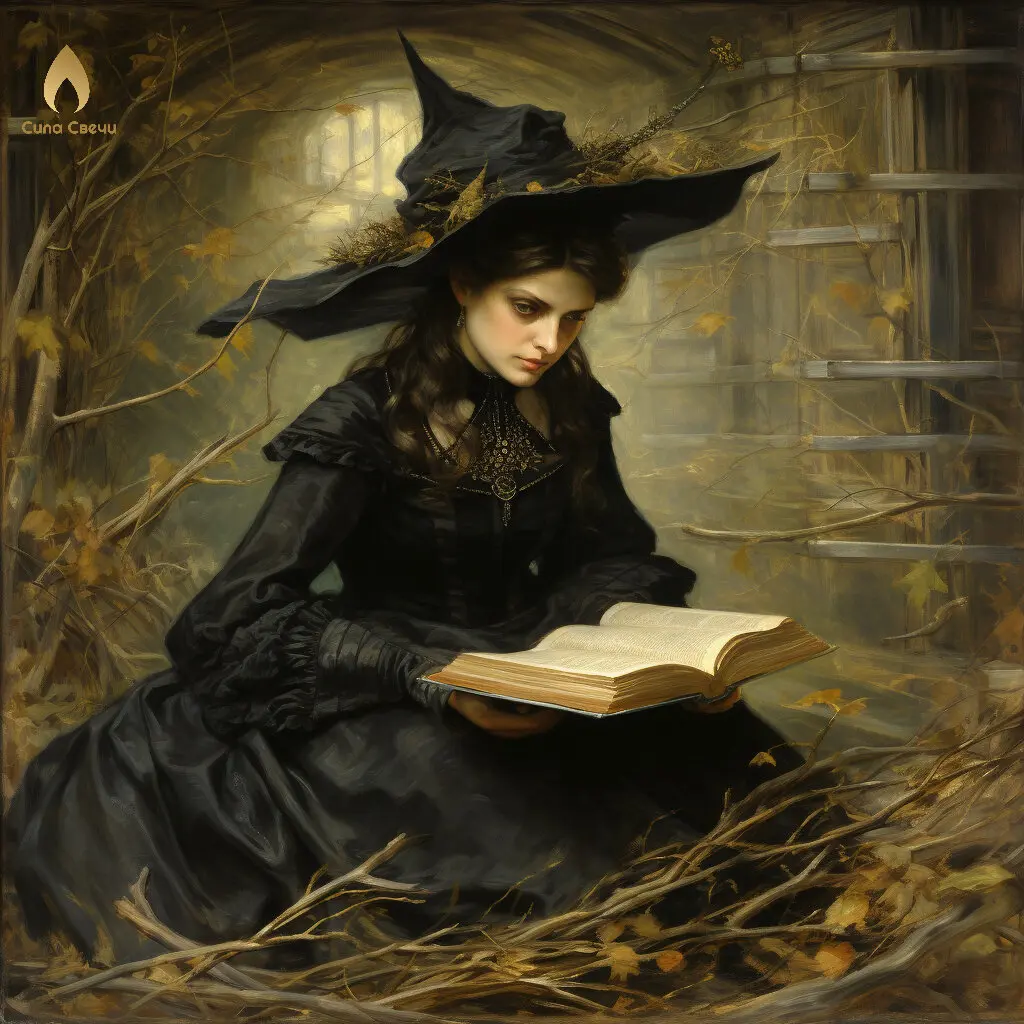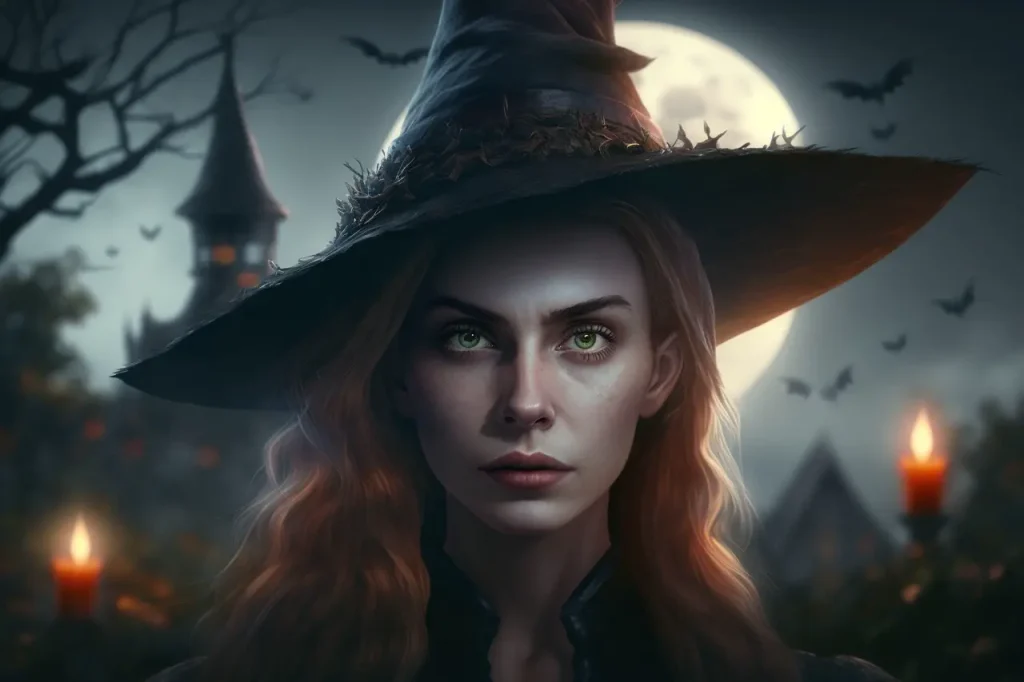Witches have been a subject of fascination and fear throughout history, evoking images of mystical rituals and powerful spells in the collective imagination. Traditional witches, in particular, have a rich heritage grounded in the old ways, where magic and nature intertwine deeply. Here, we unravel the enigma surrounding these practitioners of the ancient arts.
Key Takeaways
- Traditional witches are often associated with historical practices and beliefs in witchcraft prior to the advent of modern systems.
- They may follow a family lineage or a cultural path of witchcraft that involves a deep connection with nature and ancestral traditions.
- Traditional witchcraft is diverse, with variations based on regional histories and lore.
- Witch symbols and tools, such as the broom, cauldron, and pentacle, have significant roles in traditional practices.
Understanding Traditional Witches
Traditional witches engage in a form of witchcraft that is deeply rooted in the old ways, often passed down through generations or tied to a specific culture’s historical practices. Unlike some modern interpretations or neo-pagan traditions like Wicca, traditional witches may not conform to a structured religious framework. Instead, they often focus on the practical application of magic, symbiotic relationships with nature, and honoring the spirits of the land and ancestors.
The Historical Context Witchcraft’s recorded history often references the practices of those deemed “witches” by their communities or by persecutors during the witch trials in Europe and colonial America. The truth of what traditional witches did is a complex tapestry that weaves folklore, herbal knowledge, and communal roles into a picture often obscured by mythology and fear.
Cultural Practices and Lineage In various cultures, traditional witches may be custodians of the old ways, practicing rituals that have been in their families for centuries. They might be healers, midwives, or spiritual guides, using their knowledge to serve their community. The specifics of these roles can vary greatly by region and tradition.


The Role of Nature and Spirits
Traditional witchcraft is profoundly connected to the cycles of nature and the spirit world. Witches of olden times were often seen as having an intrinsic bond with the earth, plants, animals, and unseen forces.
Working with the Land Witches historically were believed to work their magic in harmony with the land, recognizing the inherent power in mountains, rivers, trees, and crossroads. They understood the seasons and the ebb and flow of life, incorporating these natural rhythms into their spells and rituals.
Ancestral Veneration Honoring ancestors is a common aspect of traditional witchcraft. These witches may maintain an altar for their forebears or incorporate offerings and invocations to ancestral spirits into their magical practices.
Tools and symbols are significant aspects of traditional witchcraft, and they are often used in rituals, spellwork, divination, and other magical practices. The specific tools and witch symbols employed can vary widely among practitioners, reflecting individual preferences and the diverse nature of traditional witchcraft. Here are some common tools and symbols often associated with traditional witchcraft:
Witch Tools:
- Athame: An athame is a ritual knife with a double-edged blade, often used to direct energy, cast circles, and invoke protective barriers. It is typically associated with the element of air or fire.
- Wand: The wand is used for directing energy and intention, and it is commonly associated with the element of air or fire. Traditional witches may craft their wands from natural materials, such as wood or crystal.
- Chalice: The chalice represents the element of water and is used to hold and consecrate liquids in rituals, including wine or water. It is often used to symbolize the feminine aspect of divinity.
- Cauldron: The cauldron is a versatile tool that symbolizes the element of earth and the womb of the goddess. It is used for mixing and brewing potions, incense, or witch herbs. It is also associated with transformation and rebirth.
- Boline: A boline is a ritual knife with a curved, single-edged blade, often used for practical purposes like harvesting herbs, carving symbols, or preparing ingredients for spells and rituals.
- Besom (Broom): The besom, often depicted as a broom, is used for symbolic sweeping and purifying of a space. It is associated with the element of air and is used to cleanse negative energy.
- Pentacle: The pentacle is a five-pointed star inscribed within a circle. It represents the elements and can be used to consecrate and bless items or to invoke protective energy. It is often associated with the element of earth.
- Crystal Ball: Crystal balls are used for scrying and divination. Traditional witches may use a crystal ball to receive insights, messages, or visions during meditation or divination rituals.
- Mirror: Mirrors are used for scrying, often with a black mirror or a mirror consecrated for divinatory purposes. Scrying involves gazing into the mirror to receive insights or visions.
Witch Symbols:
- Triple Moon: The triple moon symbol represents the phases of the moon (waxing, full, and waning) and the triple goddess (maiden, mother, and crone). It symbolizes the cyclical nature of life, death, and rebirth.
- Triple Spiral: The triple spiral symbol, also known as the triskele, is associated with Celtic traditions and symbolizes concepts like life, death, and rebirth or land, sea, and sky.
- Horns of the Moon: This symbol, often depicted as crescent moons facing each other, represents the waxing and waning phases of the moon and can be used in lunar magic.
- Wheel of the Year: The Wheel of the Year symbolizes the eight Sabbats or seasonal festivals, marking the cycle of the seasons and the agricultural and spiritual changes that occur throughout the year.
- Protection Runes: Traditional witches may inscribe or draw protection runes on objects or around their magical circles for protection and warding.
- Sigils: Personalized sigils are created by traditional witches to represent specific intentions or desired outcomes. These symbols are charged with energy and incorporated into spells.
- Herbs and Plants: Various herbs, plants, and their correspondences are essential symbols in traditional witchcraft. Different plants are associated with specific magical properties and are used in spells, potions, and rituals.
- Sacred Geometry: Symbols such as the Flower of Life, the Tree of Life, and the Vesica Piscis are used in sacred geometry and have particular significance in traditional witchcraft.
The tools and symbols used in traditional witchcraft often hold personal and ritualistic significance for the practitioner. These items are not just instruments but also conduits for energy, intention, and connection with the spiritual and magical realms. Traditional witches may also use their tools and symbols in accordance with their specific traditions or practices, emphasizing the importance of personal experience and direct connection with the craft.
Tools and Symbols in Traditional Witchcraft
Traditional witches make use of various tools and symbols, many of which have become iconic in the portrayal of witchcraft.
Witch’s Broom The broom or ‘besom’ is a symbol of purification and protection. It’s used to symbolically sweep away negative energies from a space.
Cauldron Often associated with alchemy and transformation, the cauldron represents the womb of the Mother Goddess in some traditions, and it is used for brewing potions and scrying.
Pentacle The pentacle, a five-pointed star within a circle, is a symbol of protection and magic. It represents the elements of earth, air, fire, water, with the top point symbolizing spirit.


Rituals and Practices
At the heart of traditional witchcraft are the rituals and practices that define the craft. From spellcasting to seasonal festivals, these actions are steeped in meaning and intention.
Spellcasting Traditional witches may use spells to bring about change in accordance with their will. These magic spells can be complex rituals or simple spoken words, charged with intention and often utilizing natural materials like herbs and stones.
Seasonal Festivals Sabbaths and other seasonal celebrations mark the passage of time and the cycle of nature. Traditional witches may celebrate solstices, equinoxes, and other significant days that correspond to agricultural or celestial events.
Modern-Day Traditional Witches
Modern-day traditional witches, also known as contemporary or revivalist traditional witches, are individuals or groups who practice a form of witchcraft that draws inspiration from historical and folkloric traditions while adapting to the needs and beliefs of the present day. These practitioners combine elements of traditional witchcraft with personal insights and contemporary influences.Today, those who identify as traditional witches often seek to preserve and revive the practices of the past. They might study historical texts, folklore, and family traditions to reconstruct the beliefs and rituals of traditional witchcraft.
FAQs on Traditional Witches
How do traditional witches learn their craft?
Some traditional witches are initiated into family traditions, while others may learn through studying historical texts, joining covens or groups that preserve these old practices, or through personal exploration and intuition.
Traditional witches, also often referred to as folk or hedge witches, learn their craft through a combination of personal experience, oral tradition, and study. The methods of learning and the specific practices can vary among individual traditional witches, as these paths are often highly personal and idiosyncratic. Here are some common ways in which traditional witches typically learn their craft:
- Oral Tradition: Traditional witchcraft often relies on passing down knowledge through oral tradition. Elders or experienced practitioners may teach their skills and knowledge directly to apprentices or family members. This oral transmission of information preserves the wisdom and practices of the tradition.
- Family or Ancestral Tradition: In some cases, individuals are born into families with a history of practicing witchcraft. They learn the craft from their parents, grandparents, or other family members who are experienced practitioners. This knowledge is often closely tied to the family’s specific regional or cultural traditions.
- Self-Study and Research: Traditional witches often engage in extensive self-study and research. They may explore historical texts, folklore, and other written sources related to witchcraft, folk magic, and herbalism. This research provides a foundation for their practice and allows them to adapt and evolve their craft.
- Personal Experience: Learning through personal experience is a fundamental aspect of traditional witchcraft. Practitioners may conduct experiments, rituals, and spells to explore the effectiveness of different techniques. They learn from their successes and failures and develop a deep understanding of the craft through direct experience.
- Observation of Nature: Traditional witches often have a strong connection to nature and the cycles of the natural world. They learn from observing the behavior of animals, the growth of plants, and the changing of seasons. This observation informs their understanding of magic and the interconnectedness of all things.
- Meditation and Spirit Work: Many traditional witches engage in meditation and spirit work to connect with spiritual entities, guides, or ancestors. Through meditation and trance-like states, they seek guidance, wisdom, and insights into their craft.
- Apprenticeships: Some traditional witches may seek out experienced mentors or elders within their tradition who are willing to take on apprentices. Apprenticeships involve hands-on learning, guided instruction, and direct mentorship.
- Community Involvement: Traditional witches may participate in local or regional communities of like-minded practitioners. They attend gatherings, workshops, and events where they can exchange knowledge, learn from others, and share experiences.
- Cultural and Regional Influences: The specific practices of traditional witchcraft can vary based on cultural and regional influences. Some traditional witches draw from the folklore and magical traditions of their particular area, adapting their craft to reflect local customs and beliefs.
- Spiritual Beliefs and Deities: The choice of deities or spiritual beliefs can be an integral part of traditional witchcraft. Some practitioners work with specific deities or spirits that guide and teach them in their craft.
Are traditional witches and Wiccans the same?
No, Wicca is a specific neo-pagan religion founded in the 20th century, while traditional witchcraft is not bound to any single system and may predate Wicca.
Traditional witches and Wiccans are not the same, although they are often associated with the broader category of modern pagan and witchcraft practices. These two paths have distinct origins, beliefs, and practices, and it’s important to understand the differences between them:
Traditional Witches:
Traditional witchcraft is a broad term that encompasses a variety of witchcraft practices rooted in folklore, historical traditions, and local customs. Traditional witches often draw inspiration from pre-modern, non-religious witchcraft practices. Some key characteristics of traditional witchcraft include:
- Non-Wiccan: Traditional witches do not follow the religious and ritual structure of Wicca, which is a specific modern pagan religion created by Gerald Gardner in the mid-20th century.
- Eclectic and Heterogeneous: Traditional witchcraft is highly eclectic and may draw from diverse sources, including folk magic, herbalism, divination, and spirit work. Practices can vary greatly depending on the individual or tradition.
- Emphasis on Ancestral and Folk Traditions: Many traditional witches place a strong emphasis on working with ancestral spirits and drawing from the folk traditions of their region or culture.
- Less Formal Ritual Structure: Rituals and practices in traditional witchcraft are often less formalized than those in Wicca, with a greater focus on intuition, personal experience, and direct connection with nature.
- No Set Moral Code: Traditional witchcraft typically lacks a standardized moral code like the Wiccan Rede. Practitioners may have their own ethical guidelines or rely on traditional, regional, or family-specific values.
Wiccans:
Wicca is a modern pagan, witchcraft-based religion that was developed by Gerald Gardner in the mid-20th century. Wicca has specific beliefs and practices, including:
- Religious Structure: Wicca is a religion with structured rituals, beliefs, and deities. It often follows the Wheel of the Year, which includes eight seasonal Sabbats, and may involve the worship of a dual deity system, such as the God and Goddess.
- Threefold Law and Rede: Wicca often adheres to the Wiccan Rede, which includes the ethical guideline “An it harm none, do what ye will.” There is also a belief in the Threefold Law, which suggests that the energy put into the world, whether positive or negative, returns to the sender threefold.
- Coven-Based or Solitary: Wiccans may practice in covens with structured initiation and training processes, or as solitaries. There is a strong emphasis on the initiation and degree system in traditional Wicca.
- Ceremonial Tools: Wiccan rituals often involve the use of ceremonial tools, such as an athame, chalice, wand, and pentacle, and a ritual circle is typically cast for magical work.
While both traditional witches and Wiccans engage in witchcraft practices, they have different origins, beliefs, and approaches to their craft. Traditional witches tend to emphasize folk and historical traditions and are more eclectic in their practices, while Wicca is a modern pagan religion with specific religious beliefs and structured rituals. It’s important to recognize and respect the distinctions between these paths within the broader world of witchcraft and paganism.
Can traditional witchcraft be practiced today?
Yes, many people identify as traditional witches and engage in practices that honor the old ways, albeit adapted to the modern world.
This exploration barely scratches the surface of the rich world of traditional witches. Their practices and beliefs are as varied as the lands from which they hail, offering wisdom, mystery, and connection to generations past.
Yes, traditional witchcraft can be practiced today, and many people around the world engage in these practices. Traditional witchcraft is a term that encompasses a diverse range of folkloric, historical, and local witchcraft traditions. It is often characterized by its emphasis on personal experience, ancestral connections, and a deep connection to nature. Here are some key points to consider if you’re interested in practicing traditional witchcraft:
- Diversity of Practices: Traditional witchcraft is highly diverse and can vary widely depending on the practitioner’s background, interests, and cultural influences. There is no single, standardized tradition, and practitioners often create their own unique path.
- Historical and Folkloric Knowledge: Many traditional witches study historical texts, folklore, and local customs to gain a deeper understanding of the practices and beliefs of their region or cultural heritage. This knowledge can inform their craft.
- Ancestral Work: Ancestral veneration and working with ancestral spirits are common aspects of traditional witchcraft. Practitioners may seek guidance and wisdom from their ancestors and incorporate their heritage into their practice.
- Nature-Based Spirituality: Traditional witches often have a strong connection to nature and the cycles of the natural world. They may observe the seasons, work with the elements, and develop a deep relationship with the land.
- Rituals and Spellwork: Traditional witchcraft includes a wide range of rituals, spellwork, divination, and herbalism. These practices are often highly personalized and based on the individual’s intuition and experiences.
- Lack of Formal Initiations: Traditional witchcraft typically does not involve formal initiations or degrees like some modern Wiccan traditions. It is often a solitary or small-group practice.
- Ethical Guidelines: While traditional witchcraft lacks a standardized moral code, practitioners may have their own ethical guidelines or draw from traditional values and ethics.
- Local and Cultural Influences: Traditional witchcraft often incorporates local and cultural influences, making it a highly adaptable and region-specific practice.
- Community and Networking: Traditional witches may connect with others who share their interests through local or online communities and covens, but the degree of formality and structure varies.
It’s important to note that traditional witchcraft is not a static or fixed tradition but an evolving and individualized path. Practitioners are encouraged to explore, adapt, and develop their practices in a way that is meaningful to them. If you’re interested in practicing traditional witchcraft, consider starting with research, self-study, and personal exploration to build a foundation for your craft. You can also seek guidance from experienced practitioners or local communities that align with your interests.


Pingback: Unveiling the Mystique of Traditional Witches |...